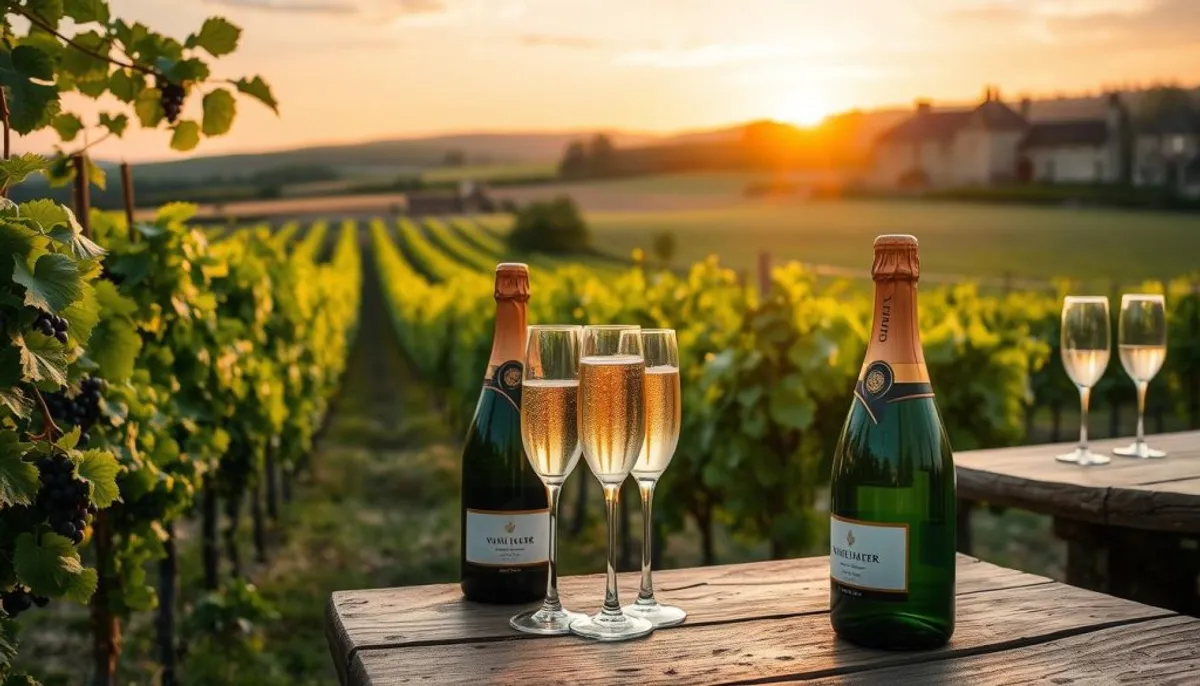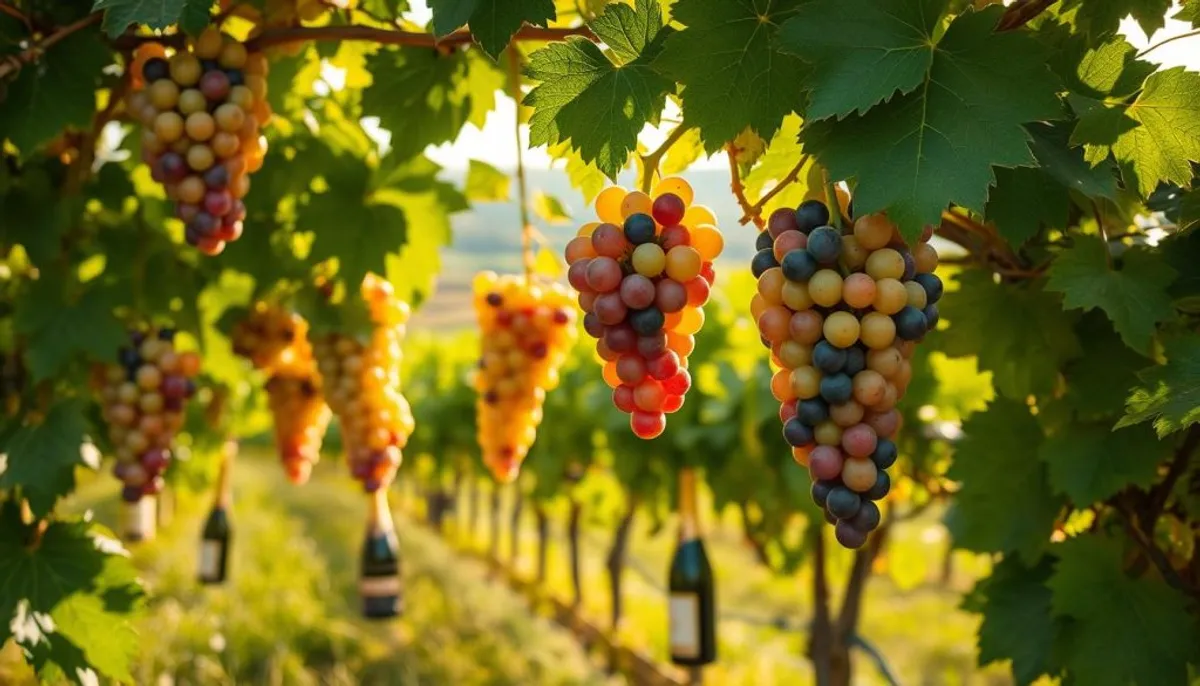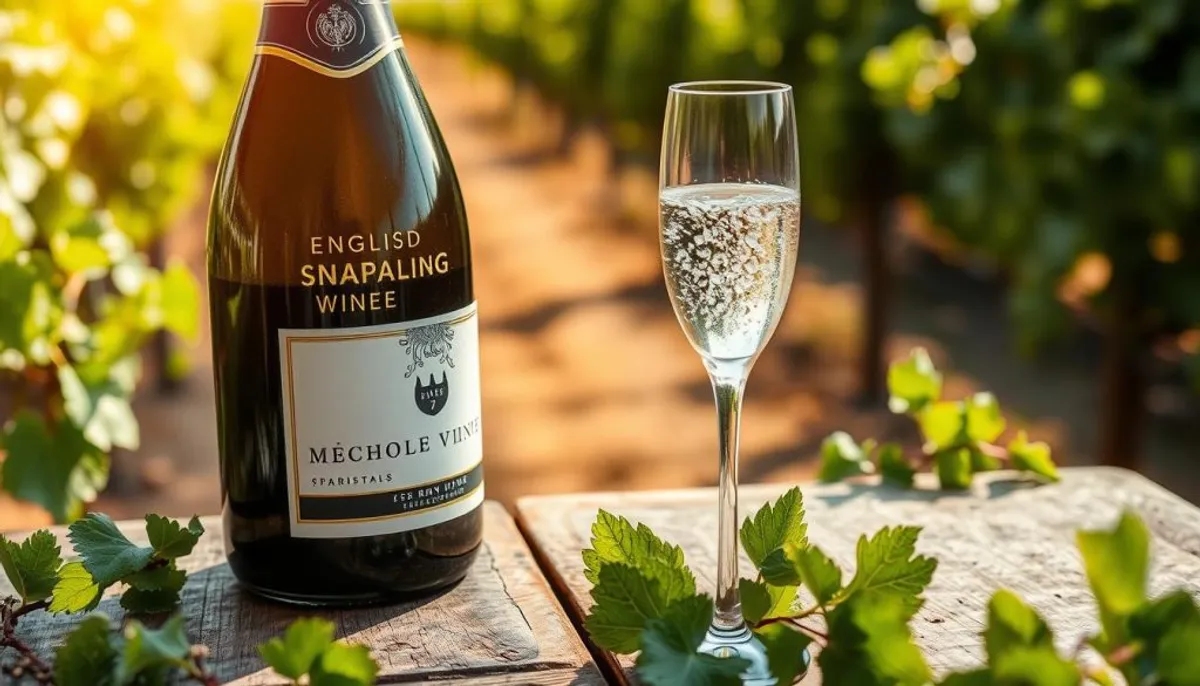English fizz has undergone a remarkable transformation since the 1970s. The UK’s wine production has surged, with British sparkling wines now on par with some of the world’s elite. Climate change has unexpectedly contributed to this success, fostering ideal conditions for grape cultivation in areas like Kent, Sussex, and Hampshire.
The traditional method, synonymous with Champagne, has become the benchmark for English sparkling wines. This technique, combined with Britain’s southern counties’ unique terroir, has yielded exceptional bottles. From the crispness of Blanc de Blancs to the elegance of rosés, UK producers are creating fizz that commands international attention.

Nyetimber’s 1992 Blanc de Blancs made history, being served at Queen Elizabeth II’s Golden Anniversary Lunch. Since then, Ridgeview and Camel Valley have set new benchmarks, with some English sparkling wines surpassing French prices. The sweet spot for these premium bubbles appears to be around £30, offering remarkable value.
Key Takeaways
- English sparkling wine industry has grown significantly since the 1970s
- Climate change has positively impacted UK wine production
- Traditional method is widely used for creating high-quality English fizz
- Key regions include Kent, Sussex, Hampshire, and Cornwall
- Chardonnay, Pinot Noir, and Meunier are the primary grape varieties used
- English sparkling wines are now competing with prestigious Champagne brands
- The average price for quality English sparkling wine is around £30
The Rise of British Sparkling Wine Industry
Since the 1970s, the UK’s wine history has undergone a transformative shift. The establishment of pioneering estates like Bolney Wine Estate marked the beginning of a new chapter in English winemaking. This period set the stage for future growth and innovation in the industry.
Historical Development Since 1970s
The modern British sparkling wine industry emerged in the 1970s and 1980s. Estates such as Nyetimber and Camel Valley were instrumental in shaping this industry. By 2022, England’s winery count had surged to 195, highlighting the sector’s rapid expansion.
Climate Change Impact on Wine Production
Climate change has been a pivotal factor in Britain’s rise to prominence in sparkling wine production. The warming temperatures in southern England have created optimal conditions for growing classic Champagne grape varieties. This includes Pinot Noir, Chardonnay, and Pinot Meunier.
Current Industry Statistics
The British wine industry has seen a significant increase in vineyard expansion. A 2022 report by Wines of Great Britain noted a 70% rise in vineyard plantings over the last five years. The industry now boasts nearly 1,000 vineyards, with Sussex alone hosting 500.
| Statistic | Value |
|---|---|
| Number of wineries in England | 195 |
| Increase in vineyard plantings (last 5 years) | 70% |
| Export rate of English wine (2022) | 4% |
| Average retail price of English sparkling wines | £20 – £40 per bottle |
With sparkling wines accounting for 64-72% of total British wine production, the industry’s prospects are bright. The increasing global recognition of English sparkling wines, alongside continued vineyard expansion, signals a promising future for this burgeoning sector.
Understanding English Sparkling Wine Production
English sparkling wine production has experienced significant growth in recent years. The industry now encompasses 209 wineries and 943 vineyards across Great Britain. With 3,855 hectares under vine in England alone, the sector continues to expand rapidly, contributing to a diverse sparkling wine selection.
Traditional Method vs Other Methods
The traditional method dominates English sparkling wine production. An impressive 93% of British sparkling wines are crafted using this time-honored technique. In contrast, only 3% employ the Charmat-Martinotti method, showcasing the industry’s dedication to quality and tradition.
Key Wine-Making Regions
Several regions stand out as primary wine production regions in England. Kent leads with 1,033 hectares of vineyards, followed by West Sussex (570 hectares) and East Sussex (473 hectares). Hampshire, Essex, and Surrey also contribute significantly to the country’s viticultural landscape.
Production Volumes and Stats
English sparkling wine dominates the nation’s wine production, accounting for 64% to 72% of total output. White varieties make up 78% of sparkling wine production, with rosé comprising the remaining 22%. The industry favors classic grape varieties, with Chardonnay (31%) and Pinot Noir (29%) leading the charge.
| Grape Variety | Percentage |
|---|---|
| Chardonnay | 31% |
| Pinot Noir | 29% |
| Pinot Meunier | 9% |
| Bacchus | 8% |
| Seyval Blanc | 3% |
Best English Sparkling Wine Varieties and Grapes
English sparkling wines have earned a reputation for their superior quality. The choice of grape varieties is key to their excellence.
Classic Champagne Grape Varieties
The grapes used in English sparkling wines are similar to those in Champagne. Chardonnay is the most prevalent, making up 31% of plantings. Pinot Noir is close behind, at 29%, with Pinot Meunier at 9%. These grapes combine to produce wines with rich flavors and complexity.

Indigenous British Varieties
While traditional Champagne grapes are dominant, some British varieties add distinctiveness. Bacchus, with 8% of plantings, contributes aromatic qualities. Seyval Blanc, at 3%, adds crisp acidity and mineral notes.
Popular Grape Blends
Many winemakers craft unique blends. A common blend includes 51% Chardonnay, 29% Pinot Noir, and 20% Pinot Meunier. This mix harmonizes fruity flavors with structural depth. Some producers also incorporate small percentages of other grapes for distinctive profiles.
| Grape Variety | Percentage of Total Plantings | Characteristics |
|---|---|---|
| Chardonnay | 31% | Citrus, apple, minerality |
| Pinot Noir | 29% | Red fruit, structure |
| Pinot Meunier | 9% | Fruit-forward, roundness |
| Bacchus | 8% | Aromatic, floral notes |
| Seyval Blanc | 3% | Crisp acidity, mineral |
Top English Wine Producers and Estates
The English sparkling wine industry has experienced significant expansion, with over 150 wineries now operating in the UK. Several producers have gained international acclaim for their exceptional quality and innovative approaches.
Nyetimber, established in 1988, stands out as a pioneer in high-quality English sparkling wine. Their commitment to excellence has earned them a reputation as one of the finest producers in the country. Ridgeview, another early entrant, quickly rose to prominence with their award-winning sparkling wines.
Gusbourne estate in Kent has made significant strides, producing one of the top-scoring English sparkling wines in blind tastings. Their Boot Hill Vineyard Blanc De Blancs Brut 2018 received a Gold medal with an impressive score of 96/100 points in the IWSC competition.
Chapel Down, located in Kent, has become a household name in English wine. They offer a wide range of sparkling and still wines, consistently receiving accolades for their quality. If you're looking for the best budget champagne in kenya, Camel Valley, situated in Cornwall, has also gained recognition for their excellent sparkling wines, notably their Pinot Noir Rosé.
| Producer | Notable Wine | Score |
|---|---|---|
| Gusbourne | Boot Hill Vineyard Blanc De Blancs Brut 2018 | 96/100 |
| Wyfold Vineyard | Rosé Brut 2018 | 96/100 |
| Roebuck Estate | Rosé de Noirs Brut 2018 | 95/100 |
These top producers have not only elevated the status of English sparkling wine but also compete with established Champagne houses in quality and prestige. Their success has paved the way for continued growth and innovation in the British wine industry, emphasizing the importance of a strong champagne brand identity.
Soil and Terroir: The British Advantage
British terroir presents a unique advantage for sparkling wine production. The distinct soil composition and climate foster ideal conditions for cultivating grapes with exceptional qualities. This environment is pivotal for the production of world-class sparkling wines.
Chalk and Limestone Characteristics
Chalk soils are crucial in English sparkling wine production. These soils can retain up to 660 liters of water per cubic meter, ensuring excellent drainage and moisture retention. The Newhaven Chalk formation in England mirrors the renowned chalk of Champagne, imparting a distinctive character to the wine.
Regional Soil Variations
The weald regions of Kent, Surrey, and East Sussex are known for their nutrient-rich soils, ideal for grape cultivation. South-facing slopes at low altitudes in these areas provide prime locations for vineyards. Limestone-rich soils, akin to those in Champagne, are widespread across British wine regions, albeit with different geological origins.
Climate and Geological Impact
Southern England’s climate is slightly cooler than Champagne’s during summer but warmer in September. This unique climate, combined with the region’s geology, creates an environment where grapes develop complex flavors and maintain high acidity levels. The synergy of chalk soils, limestone, and favorable climate conditions in British terroir is key to producing world-class sparkling wines.
Premium English Sparkling Wines Under £40
English sparkling wines have earned a reputation for their high quality and affordability. The market now offers a variety of English sparkling wines, including a curated sparkling wine selection that competes with more expensive Champagnes. We will examine some of the top mid-range sparkling wines that provide outstanding taste without a hefty price tag.

Wine aficionados looking for value will find numerous excellent options between £20 and £40. Morrisons The Best English Sparkling Brut Vintage is a standout, scoring 89/100 at just £24. Chapel Down Brut is close behind with 88/100 at £27. Tesco Finest English Sparkling Wine offers great value at £21, with a score of 86/100.
For those who prefer organic wines, Oxney Organic English Sparkling Wine scores 87/100 and is priced at £30. Rosé enthusiasts should consider Simpsons Wine Estate Canterbury Sparkling Rosé, which earned a remarkable 90/100 and costs £34.
| Wine | Score | Price |
|---|---|---|
| Morrisons The Best English Sparkling Brut Vintage | 89/100 | £24 |
| Chapel Down Brut | 88/100 | £27 |
| Oxney Organic English Sparkling Wine | 87/100 | £30 |
| Simpsons Wine Estate Canterbury Sparkling Rosé | 90/100 | £34 |
These mid-range sparkling wines highlight the diversity and quality of English viticulture. From crisp Bruts to elegant rosés, there’s a perfect bottle for every taste and occasion. Their affordability makes them ideal for both casual enjoyment and special celebrations.
Luxury English Sparkling Wine Selection
The luxury English sparkling wine market has witnessed a significant surge, with sales increasing by 69% between 2019 and 2021. This growth underscores the escalating quality and prestige of these high-end wines. They now rival the esteemed Champagne houses in the market.
Premium Blanc de Blancs Options
Premium Blanc de Blancs stand out for their finesse, a testament to English terroir. Crafted from 100% Chardonnay grapes, these wines boast crisp acidity and intricate flavors. Prices span from £27 to £480, catering to both aficionados and collectors.
Prestige Cuvées
English luxury cuvées are gaining prominence in the sparkling wine realm. The Ridgeview Blanc de Noirs 2014/15, priced at £48.71, was crowned the best overall English sparkling wine for 2023. These blends, often featuring classic Champagne grapes, deliver wines of profound depth and character.
Limited Edition Releases
For those in pursuit of exclusivity, limited edition releases offer unparalleled tasting experiences. The Founder’s Edition Duo, priced at £155, epitomizes this category. These rare bottles, sourced from single vintages or specific vineyard plots, showcase the pinnacle of English winemaking prowess.
| Wine Type | Price Range | Notable Features |
|---|---|---|
| Single Bottles | £27 – £480 | Wide range of styles and vintages |
| Cases (6 bottles) | £162 – £1,440 | Ideal for cellaring or gifting |
| Magnums | £66 – £89 | Perfect for celebrations |
The diversity and quality of high-end English sparkling wines continue to impress, offering options for every preference and occasion. From the crisp Blanc de Blancs to the rich prestige cuvées, these wines exemplify the zenith of British viticulture.
Food Pairing with English Sparkling Wines
English sparkling wines have emerged as a cornerstone in the culinary world, offering a plethora of pairing options. Their high acidity and intricate flavors make them ideal companions for a broad spectrum of dishes, including various sparkling wine varieties.
For canapés and starters, Chapel Down Brut, Nyetimber Classic Cuvée, and Denbies Bacchus Fizz under £15 stand out. These sparkling wines beautifully complement light appetizers, enhancing the flavors of seafood and delicate hors d’oeuvres.
Main courses showcase the brilliance of English wine and food pairings. Light red wines, such as Pinot Noir from Bolney Estate or Balfour, pair wonderfully with roast turkey and traditional Christmas trimmings. For seafood enthusiasts, white wine variations like Bacchus, Pinot Gris, and Chardonnay are perfect for salmon and prawns.
Dessert pairings reach new heights with English sparkling rosé. Hush Heath Balfour Sparkling Rosé and Ridgeview Fitzrovia Rose are ideal for Christmas pudding, mince pies, and fruitcake. For cheese boards, Stilton or brie paired with Rowton Vineyard’s Late Harvest Solaris or Once Upon a Tree’s The Wonder Pear Ice Wine is a must-try.
The versatility of English wines opens up a world of creative pairing possibilities. Whether it’s seafood, meaty dishes, or desserts, there’s an English sparkling wine to enhance every culinary adventure.
Investment Potential and Market Growth
The English wine market is witnessing a significant upswing, with sparkling wine investment leading the charge. Over the past five years, production has skyrocketed by 130%, hitting 12.2 million bottles in 2022. This surge underscores the burgeoning interest in English wines and the luxury automotive industry, which has also seen a rise in premium offerings.
Current Market Trends
England’s vineyards have expanded dramatically, now covering almost 10,000 acres, a 74% increase since 2017. This expansion has drawn substantial investment, with £480 million flowing into vineyards and wineries between 2018 and 2022. Sparkling wines, in particular, dominate the market, making up 68% of total production.
Future Growth Predictions
The outlook for English sparkling wine investment is optimistic. Projections suggest vineyard acreage will nearly double to 19,000 acres by 2032, potentially yielding 25 million bottles annually. The value of land suitable for wine growing has skyrocketed, reaching £40,000-£50,000 per hectare, reflecting the increasing investor interest.
Export Opportunities
Wine export trends indicate a promising future for English producers. Gusbourne, a premium winery, now exports to 35 markets, accounting for 21% of its total revenue. Balfour Winery aims to export 10% of its expected 900,000-bottle production this year, showcasing the growing global demand for English sparkling wines and the diverse sparkling wine selection available to consumers.
| Metric | Value |
|---|---|
| Production Growth (Last 5 Years) | 130% |
| Current Vineyard Area | 10,000 acres |
| Projected Vineyard Area (2032) | 19,000 acres |
| Investment (2018-2022) | £480 million |
| Sparkling Wine Production Share | 68% |
Conclusion
The English wine future appears radiant, with the British wine industry experiencing exponential growth. Since 1995, Ridgeview has garnered numerous accolades, while Nyetimber’s vast vineyards in Sussex, Hampshire, and Kent have elevated English sparkling wine quality. Producers like Camel Valley, with over three decades of experience, and Hattingley Valley, a recent entrant, are redefining excellence.
Gusbourne’s dedication to sustainable practices and meticulous winemaking has borne fruit. English sparkling wines now receive international acclaim, rivaling the likes of Champagne. The classic Champagne grape varieties, Chardonnay, Pinot Noir, and Pinot Meunier, are the foundation. Unique varieties like Seyval Blanc, on the other hand, introduce a distinctive flair to English sparkling wines.
As English sparkling wines gain recognition, their versatility becomes more apparent. From the refreshing Blanc de Blancs to the robust Blanc de Noirs, there’s a style for every taste. Emerging regions like Norfolk are joining the established Sussex and Kent, each bringing its unique terroir to the English wine landscape. With the right serving temperatures and pairings, English sparkling wines are poised to enchant wine lovers globally, solidifying their standing in the international sparkling wine market.
RelatedRelated articles



